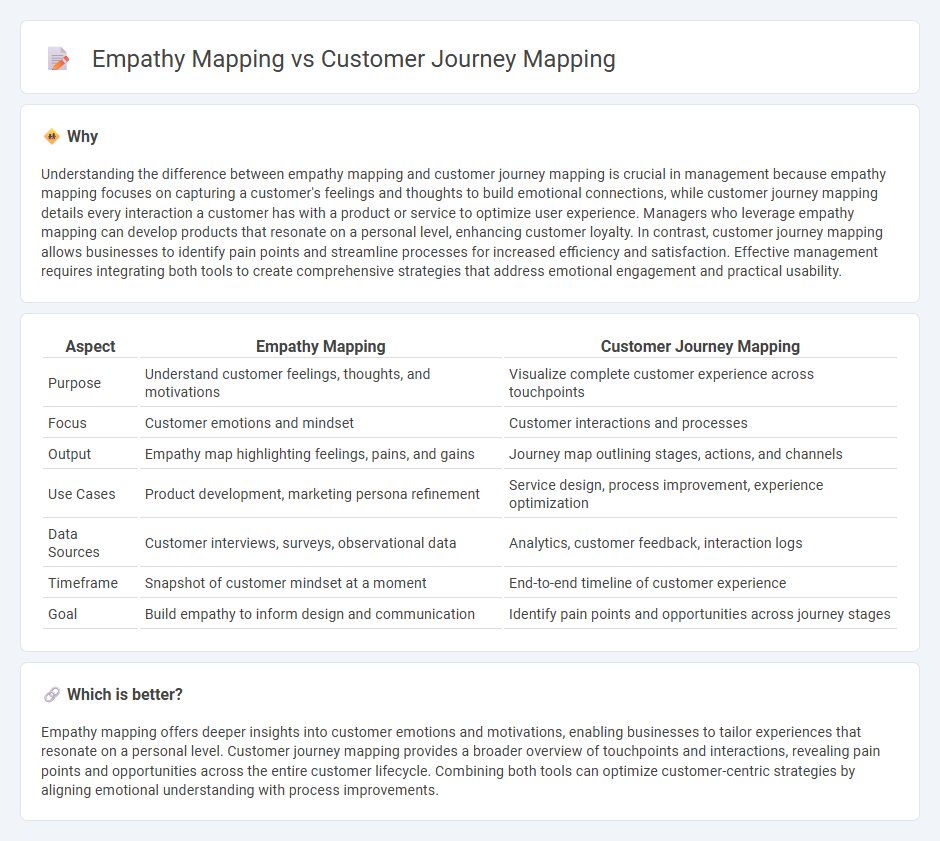
Empathy mapping focuses on understanding customers' feelings, thoughts, and pain points to create buyer personas, while customer journey mapping illustrates the step-by-step experience users have with a product or service. Both tools enhance customer-centric strategies by offering insights that drive targeted improvements and personalized engagement. Explore these methods further to optimize your management approach and elevate customer satisfaction.
Why it is important
Understanding the difference between empathy mapping and customer journey mapping is crucial in management because empathy mapping focuses on capturing a customer's feelings and thoughts to build emotional connections, while customer journey mapping details every interaction a customer has with a product or service to optimize user experience. Managers who leverage empathy mapping can develop products that resonate on a personal level, enhancing customer loyalty. In contrast, customer journey mapping allows businesses to identify pain points and streamline processes for increased efficiency and satisfaction. Effective management requires integrating both tools to create comprehensive strategies that address emotional engagement and practical usability.
Comparison Table
| Aspect | Empathy Mapping | Customer Journey Mapping |
|---|---|---|
| Purpose | Understand customer feelings, thoughts, and motivations | Visualize complete customer experience across touchpoints |
| Focus | Customer emotions and mindset | Customer interactions and processes |
| Output | Empathy map highlighting feelings, pains, and gains | Journey map outlining stages, actions, and channels |
| Use Cases | Product development, marketing persona refinement | Service design, process improvement, experience optimization |
| Data Sources | Customer interviews, surveys, observational data | Analytics, customer feedback, interaction logs |
| Timeframe | Snapshot of customer mindset at a moment | End-to-end timeline of customer experience |
| Goal | Build empathy to inform design and communication | Identify pain points and opportunities across journey stages |
Which is better?
Empathy mapping offers deeper insights into customer emotions and motivations, enabling businesses to tailor experiences that resonate on a personal level. Customer journey mapping provides a broader overview of touchpoints and interactions, revealing pain points and opportunities across the entire customer lifecycle. Combining both tools can optimize customer-centric strategies by aligning emotional understanding with process improvements.
Connection
Empathy mapping and customer journey mapping are interconnected tools in management that enhance understanding of customer experiences by capturing emotional states, needs, and pain points throughout their interaction with a brand. Empathy mapping focuses on the customer's feelings and thoughts, providing qualitative insights that inform the stages and touchpoints detailed in customer journey mapping. Together, they enable organizations to create more user-centered strategies by aligning emotional insights with behavioral data across the entire customer lifecycle.
Key Terms
**Customer Journey Mapping:**
Customer Journey Mapping visually represents every interaction a customer has with a brand across multiple touchpoints, identifying pain points and opportunities for improvement along the entire buyer's journey. It emphasizes understanding customer behaviors, emotions, and motivations from initial awareness to post-purchase stages, enabling businesses to optimize user experience and drive loyalty. Explore deep insights into how Customer Journey Mapping can transform your customer engagement strategies.
Touchpoints
Customer journey mapping meticulously outlines each touchpoint a customer interacts with, capturing the full experience across channels and time to identify pain points and opportunities. Empathy mapping centers on understanding customer emotions, thoughts, and motivations at specific touchpoints, revealing deeper psychological drivers behind behavior. Explore how leveraging these distinct approaches can enhance customer experience strategies and improve touchpoint effectiveness.
Customer Stages
Customer journey mapping visually outlines each phase a customer experiences from awareness to post-purchase, highlighting key touchpoints and interactions that influence their decision-making process. Empathy mapping delves into the emotional and psychological states of customers during these stages, capturing their thoughts, feelings, and pain points to foster deeper understanding. Explore more to effectively align customer experience strategies with behavioral insights.
Source and External Links
The customer journey map and why it's important - A customer journey map is a visual representation of interactions between customers and companies, helping businesses predict behavior and direct responses effectively.
What is a Customer Journey Map? - This page provides an overview of customer journey maps, including creating personas, identifying key stages, and determining touchpoints to understand customer experiences.
30 Best Customer Journey Mapping Tools of 2025 - This article lists various tools for creating customer journey maps and provides guidelines on how to make them effectively by tracking customer interactions and experiences.
 dowidth.com
dowidth.com